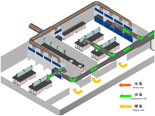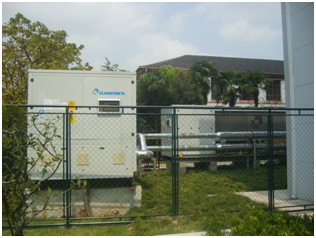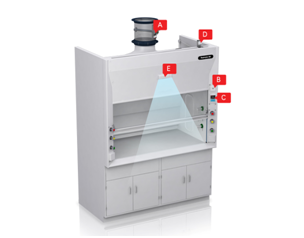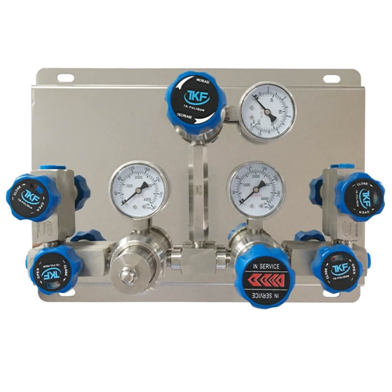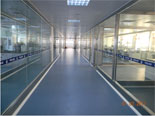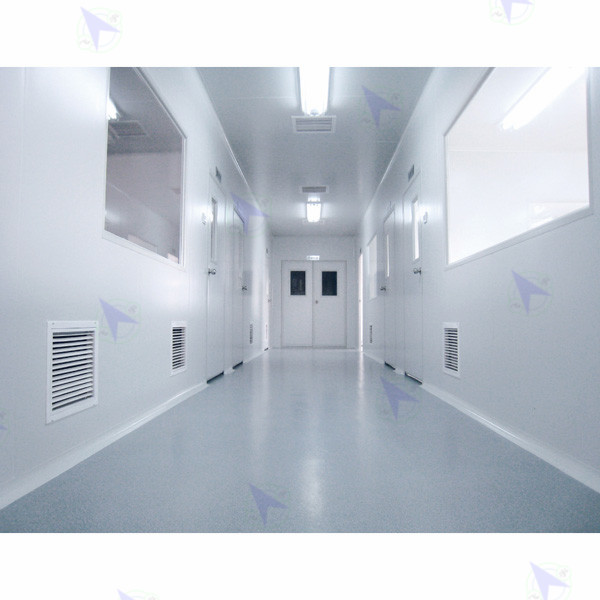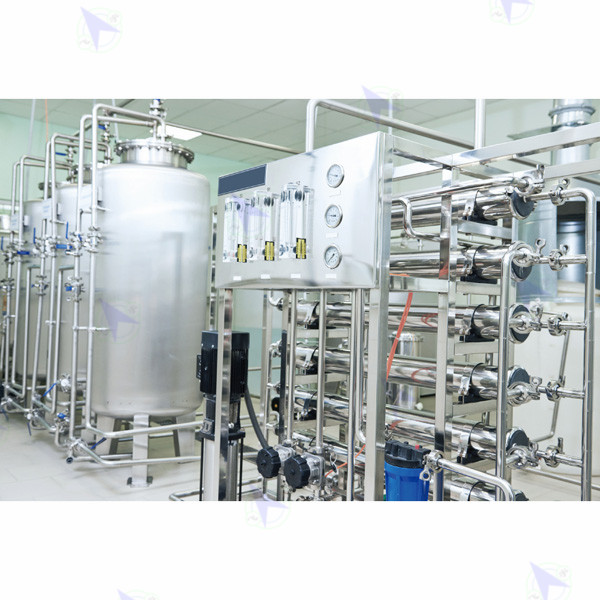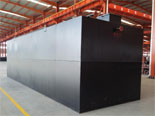实验室排风系统工程
Laboratory airflow control speciality design requirements / 实验室气流控制系统设计要求
In any case, air should always flow from the office, the corridor and auxiliary areas into the lab area. And all chemical laboratory exhaust gas should be directly discharged to the outside, and mustn’t be recycled. Therefore, unless chemical laboratory is required to clean itself, its relative to other space within a building maintains negative pressure of the camp.
在任何情况下,气流均应从办公室、走廊和辅助区域进入实验室区域,所有化学实验室排出的气体均应直接排放至室外,而不得循环利用。因此,除非化学实验室本身有洁净要求,否则其相对楼宇内其他空间,均应维持负压。
Experiment indoor airflow should be from low risk areas to high risk areas. Generally speaking, it should keep the flow of gas 47 liters per second between the above area (170 cubic meters per hour). Office areas in a laboratory should always maintain a positive pressure relative to the corridor and laboratory.
实验室内气流应从低危险区域流向高危险区域。一般来说,应维持上述区域之间47升/秒(即170立方米/小时)的气流量。实验室建筑的办公区域,应相对于走廊和实验室始终维持正压。
Under normal conditions, 6-12 times every hour’s room air changes are considered appropriate. When there is analysis equipment which is likely to produce high heat load or there is large local exhaust air in the room, there will be a need to increase in volume.
通常情况下,6-12次/小时的房间换气次数都被认为是合适的。当实验室内有可能产生高热负荷的分析设备,或房间内有较大量的局部排风时,则可能需要相应增大换气量。
The laboratory should adopt 100% full fresh air system, the central air supply unit and compensate laboratory exhaust demand.
实验室应采用100%全新风系统,采用中央新风机组送风,并补偿实验室排风需求。实验室排风不得循环利用于其它通风需求。
In order to ensure the safety of the staff, keep the distance of discharge point and flat roof at least 3 meters (ten feet) or even higher in order to exhaust emissions and effectively diluted. The specific choice should be calculated to confirm.
为保证人员的安全,应保持尾气排放点距离屋顶平面最高点至少3米(即10英尺),甚至可能要求更高,以便尾气有效地排放及稀释。具体选择应经过计算确认。
Interpretation of variable air volume speciality / 解读变风量系统
In the large ventilation system, in order to solve the ventilation equipment at the end of the variable air volume demands and constant wind speed and to achieve further adjustment, we apply the frequency conversion and variable air volume ventilation control.
在大型通风系统中,为了解决通风设备末端的变风量要求和面风速恒定的要求,实现进一步调节。我们应用变频+变风量通风控制来解决。
Interpretation of the variable air volume speciality
解读变风量系统
Laboratory airflow control aims
实验室气流控制目标
Security (Accord with the regulations and standards)
安全性(符合规范要求)
Local exhaust control
局部排风控制
Regional pressure control
区域压力控制
Energy-saving
降低能耗
Easy to maintenance and management
易维护管理
Availability and flexibility
系统灵活性
Adaptive control (Temperature and humidity)
舒适性控制(温湿度)
Variable air volume control ventilation:Every country has strict requirements of the ventilation cabinet winds, For laboratory ventilation cabinet is the most important level of protective equipment. Generally we should always maintain constant ventilation counter wind speed of 0.5 m/s. Too high or too low surface wind speed can produce dangerous side leakage.
通风柜变风量控制:通风柜作为化学实验室内最重要的一级防护设备,各国对于通风柜的面风速均有严格要求。通常要求始终维持通风柜面风速恒定为0.5m/s。过高或者过低的面风速,均会产生泄漏危险。
Local exhaust control: Cover cabinet , atomic absorption, reagent cabinets and some other local exhaust control should be able to continuously and effectively control and discharge the exhaust gases quickly and securely.
其他局部排风控制:对于万象抽气罩、原子吸收罩、试剂柜等局部排风设施,应能够持续、高效地控制,安全迅速地将气体排出。
Room pressure control: Generally we should maintain negative pressure of the laboratory relative to that of the corridor in order to avoid cross contamination of the office or production areas.
房间压力控制:通常情况下要求始终保持实验室相对于走廊的负压,以免对周围办公或生产区域造成交叉污染。
Reduce energy consumption: On the premise of safety, significantly reduce energy consumption, including air conditioning and fan energy consumption.
降低能耗:在充分满足安全的前提下,大幅降低运行能耗,包括空调以及风机能耗。
The working principle of ventilation counter wind speed control
system / 通风柜面风速控制系统工作原理
1、Surface wind speed control system
continuously monitor s the actual exhaust air volume of the fume cabinet .
Calculate the average wind speed of the open area according to the height of the
window. When the exhaust pipe pressure changes or the window height changes, the
system responses within a second and adjust the opening of the air valve to keep
the average surface wind speed of the window open surface
stable.
面风速控制系统持续地监测通风柜实际排风量,根据视窗高度计算出视窗开口面积的平均面风速,当排风管道压力变化或视窗高度发生变化时,系统在≤1S的时间做出反应,及时调整风阀开度保持视窗开口面积的平均面风速稳定。
2、Under
different experimental conditions, we can set different parameters on the
panel.
不同实验状况时,可在面板上设置不同的参数。
3、The system controls surface wind speed at
a set speed ( 0.5m/s) through infrared detector when there is an operator in
front of the ventilation cabinet and the system automatically switches to
another value(e.g. 0.3m/s) to save costs when there is no operator in front of
the fume cabinet
.
系统通过红外线监测器当通风柜前有操作人员工作时面风速控制在某一设定值(0.5m/s),当通风柜前无人操作时,系统自动转换到另一设定值(如0.3m/s)以节省运行费用。
4、When
ventilation cupboard door was off, the air valve maintains the minimum of the
ventilation cabinet exhaust air 1500MM , the ventilation cabinet
300CMH.
当通风柜门关闭后,风量阀要维持通风柜的最小排风量,1500MM通风柜为300CMH。
5、Due to the fault
surface wind speed is high or low, there will be sound-light
alarms.
由于故障面风速过高或过低时有声光报警。
6、When temperatures of ventilation cabinet
are high, there will be sound-light alarms.
通风柜温度过高时有声光报警。
7、When the
position of the ventilation cabinet is too high, there will be sound-light
alarms.
通风柜门位过高时有声音报警。
8、When there is an exception, open the emergency
discharge mode control and the system will open all the air valves. The
maximum air volume of the ventilation cabinet s is free from the control of the
wind speed value.
当出现异常情况时,开启紧急排放模式控制,系统将全部打开风阀,本台通风柜最大风量,不受面风速值的控制。
We provide laboratory for variable air volume systems CON-LABC with VAV fume
hood control system CON-FHC,using the world’s most advanced VAV solutions
through a digital controller for laboratory supply and exhaust,fume hood face
velocity for strict monitoring and
control.
我们提供的实验室变风量体统CON-LABC与通风柜变风量控制系统CON-FHC,采用世界最先进的VAV解决方案,通过数学控制器对实验室送排风、通风柜的面风速,进行严格的监视与控制。
Security no matter how to adjust the opening window, you can always precise
control of the fume hood wind speed of 0.5m/s+ 20% of imports. At the same time
the exhaust valve air flow tracking changes in the amount of wind to send the
air valve to increase or decrease exhaust volume to ensure that the design of
the infiltration air flow is constant, thus ensuring a laboratory micro-negative
pressure and airflow direction. System strong adaptability, and energy
consumption can be decline to fully protect the safety on this
premise.
保障无论调节窗开度如何,始终可以精确控制通风柜进口风速为0.5m/s.同时排放阀风量追踪送风阀的风量的变化。增大或减小排风量,以保证设计的渗透风量恒定,从而保证实验室的微负压及正确的气流方向。系统适应性强,可以在充分保障安全的前提下降低能耗。

